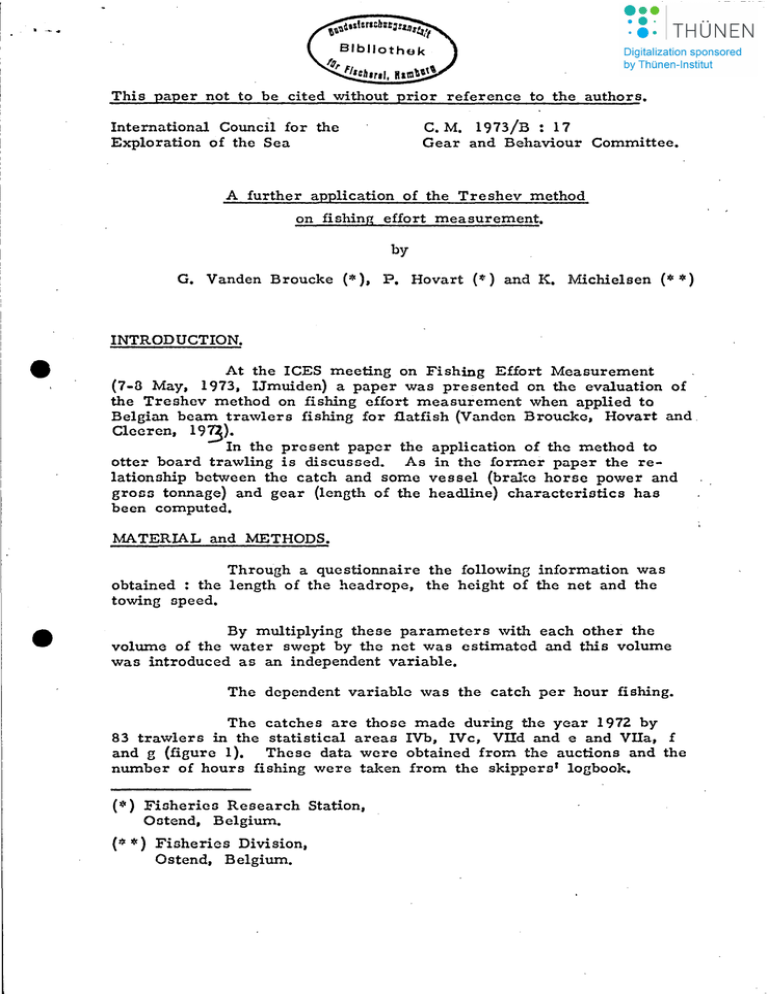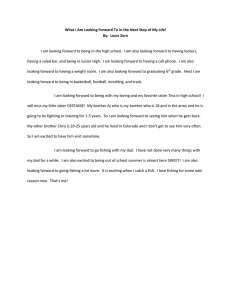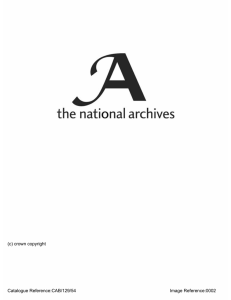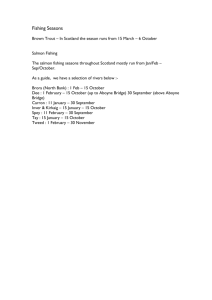. ..
advertisement

. --- . This paper not to be cited without prior reference to the authors. International Council for the Exploration of the Sea C. M. 1973/B : 17 Gear and Behaviour Committee. A further application of the Treshev method on Hslling effort measurement. by G. Vanden Broucke (*), P. Hovart (lI') and K. Michielsen (* *) INTRODUCTION. • At the ICES meeting on Fishing Effort Measurement (7-3 May, 1973, IJmuiden) a paper was presented on the evaluation of the Treshev method on fishing eifort measurement when applied to Belgian beam trawlers fishing for flatfish (Vanden Brouckc, Hovart and. Clccrcn, 19~). In the present paper the application of the method to otter board trawling is discusscd. As in thc former paper the relationship between thc catch and some vesscl (brakc horse power and gross tonnage) and gear (length of the headline) characteristics has been computed. lviA TERIAL and METHODS. Through a questionnaire the following information was obtained : the length of the headrope, the hcight of the net and the towing speed. • By multiplying these parameters with each other the volwnc of the water swept by the net was estimated and this volume was introduced as an independent variable. The dcpendent variable was the catch per hour fishing. The catches are those made during the year 1972 by 83 trawlers in the statistical areas IVb, IVc, VIId and e and VIIa, f and g (figure 1). Thesc data wcre obtained from the auctions and the nwnber of hours Hshing were taken from the skippers' logbook. (*) FishericG Research Station, Ostend, Belgiwn. (* *) Fisherics Division, Ostend, Belgiwn. .. 2. Using these variable 0, linear regressions and corresponding correlation coefficients were calculated. A second seriell of calculationll was carried out with as independent variables consecutively brake horse power, gross tonnage, as recorded in the ship certificatc, and the length of hcadrope. The gear used by these vessels was the ott.er bottom trawl. Table 1 gives information about the characteristics of vessels and gear and about the catches. • RESULTS • Table 2 shows the linear regressions with consecutively as independent variables : the volume of water swept by the net, the brake horse power, the gross tonnage and the length of the headrope. The individual distribution of thc data can bc found on figures 2, 3, 4 and 5. All regression coefficients are_lJ..i.g1;1y oignüicant. The correlation eoefficient with the swept water volume as independent variable, is in aecordanee with thc results obtained by Guiehet for vessels using the 32 m "LR" trawls (R 0, 65), but is quite smaller than the. one obtained by Treshev (R = 0, 97). = • Moreover, it was not the highest eoefficient obtained, as ean be seen in table 2. Thc eorrclation coefficient with engine output as independent variable is quitc higher and even cross tonnage gave a slightly better result• However, thc results of the present study based on a larger sampie are somewhat more favourable to Trcshev' s method than those of the former one. CONCLUSIONS. 1. The present study, using data eoncerning 83 trawlers fishinr; with otter bottom trawls, gave results which are slightly more favourable to the Treshev method than the former one, based on data concerning 49 trawlers using the twin beam trawl methode Perhaps the higher eorrelation coefficients ean be traced down to thc sample being larger. . J 3. 2. However, the estimates of the vo1ume of water filtered by the net were much more rudimenta1 as this time al three parameters (speed, width and height) had to be based on the skippers guesses whereas in the former paper this was on1y the case with one (speed). 3. In both cases data concerning fishing on quite different stocks were used, which tendo to influence u"·lfavourab1y the corre1ation coefficients. • 4. On the other hand Treshev' s method is meant to be a basic method of mcasuring fishing effort of very different Hshing gear and ships on a givcn stock, or to measure stock. abundance • 5. For this reasons some refinements in the approach to thc problem Seem to be necessary : a. Standardisation of measurement of the sv/ept volume, b. If different stocks are taken in to the same sampie, some wn.y of eliminating the influence of their respcctive densities should be devised (cfr Gul1and), c. Larger samples inc1uding data of different fishing methods (otter board, beam trawl, pe1agic trawl) should be studie~ d. Partial corre1aticn coefficients concernine the different independent variables should be computed, to determine clearly which one of them is the most important. • REFERENCES . G. Vnnden Broucke, P. Hovart and G. Cleeren - An application of the Treshev method on fishing eifort measurement - leES - Meeting on Fishing Eifort Measurernent, IJmuiden, 193. R. Guichet - Relations entre 1e pouvoir de peche determine experimentalement, la puissance utilisee en p~che et 1e volume d'eau filtre par unite de temps - Exemp1es calcules sur la p~chc du merlu des chalutiers rochelais - ICES - Meeting on Fishing Eifort :Measurement, IJmuidcn, 1973. A. I. Treshev - Fishery parameters assessment method - leES Meeting on Fishing Effort Mcasurement, IJmuiden, 1973. Table 1 - The characteristics cf the vessels, the gear and the catches. ...... i II Number cf vessels Vclume cf the water swept Range I 83 45.176298.018 H.P. G.T. I Average Range I Average 151 624 90- 268,45 0 510 Range 23,17154,61 L cf headline Average Range Average 78,67 10,36- 18,72 24,99 Catch per hcur fishing R~ge I Average 23,3- 67,09 149,1 ...;:. - .- 5. Table 2 - Regression Y ;:: a .. -- volume of water swept b X (Y ;:: catch per hour fishing) Regression equation Independent variable y + Y ;:: 15, 572 0,00034 X (0, 00004) (ass) -~ - + ~ R R 2 l --' 0,638 0.407 0, 763 0, 582 0,663 0,140 0,547 0,299 8.50 - • X ;:: y bra..."<.e horse power ;:: 5, 562 + 0,22923 X (0, 02159) (sos) = 10.62 t X ;:: Y groDs tonnage ;:: 18) 203 + 0:62147 X (0, 07802) (8SS) t - 7,97 ' "I,. .t.. ;:: Y length of headrope ;:: -21,843 + 4,75162 X (0, 80741) (sos) t ;:: 5,89 J (DSS ;:: • significant p < O. 0001) ....1' I -I I I ! , I I 1_ I i hin I ~----- Catch Ikg/h.f. Figüre 2 300 250 200 . \ 150 .. •:' • • . ....• • . .' . .- . • • • • • 100 ....••. ....e.,.• •. . •.. • • so . •• • • . ..••• • .. -. • Q'-------L---_.J.- 100.000 200.000 • --L 3OQ000 -l- 40QOOO --1 500.000 Volume of the water swept (m 3 ) ........ C~tch/kg/h.f. Figurc 3 300 250 200 150 • • • •• • • •• • 100 . • .. .. · •• 50 • t " • • . .• ..• • • ~ · • t t • • •• • • • .... , . • • .'·• •• • Herze power 0 100 200 300 400 :r--- 500 --- - --- - - - - - - - - - - - - - - - - - - - - - - - - - - - - - - - - - - - - - - - - - - - - - - - - - - - - - - - - - - - - - - 1 e· Catch/kg Ih.f. 300 Figure 't 250 . 200 '. 150 • • 100 • 50 •• 25 • .tf. " .. 50 ••• •• .. •• • • ••• o •• • •• o • • . .- o· 75 • • " .0 • •• • • • • 100 • • • • Catch/kgl h.f. Figure 5 ~300 250 r . - 200 150 , ,. • • e. 100 • • 0 • • 50 . 0 • • ". • • • .. ;":. • o' • • • • • • ' • • • • . •· .' •... • o' . • • • • : • . •• •• • • •• • • •• • e Length of head ropeC mJ 5 10 15 20 25 -





